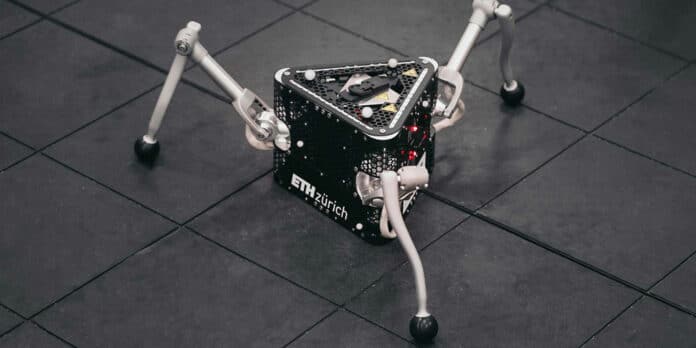As part of the SpaceHopper project, the ETH Zurich students are designing a robot that can navigate low-gravity environments using a jumping-like mode of locomotion.
One day the SpaceHopper will be deployed on space missions to explore relatively small celestial bodies such as asteroids and moons. These are thought to contain valuable mineral resources that could be of use to humankind in the future.
The SpaceHopper program was first launched two and a half years ago as an ETH focus project for Bachelor’s degree students. The project has been continued and is now being researched by a team of Master’s and doctoral students.
Developing exploration robots for small celestial bodies would be quite challenging due to the low gravity prevailing on small celestial bodies – in contrast to larger bodies such as Earth. Such bodies in space could hold valuable resources like rare-earth metals, and exploration of these bodies could also give us insights into our universe’s formation.
The SpaceHopper robot is designed with a triangular body made of aerospace-aluminum, featuring articulated legs with hip and knee joints. With two motors moving the hip and another moving the knee via a differential drive mechanism, the robot is poised to explore the depths of space and gather vital information.
The SpaceHopper robot uses deep-learning-based software to control its leg movements and allow it to perform a variety of functions. This includes initiating hops, maintaining orientation while in flight, and landing at predetermined locations.
All nine leg motors work together to launch the robot high off the asteroid’s surface, and how it can selectively extend or withdraw its legs to shift its center of mass and maintain its upright orientation while in the air. The robot’s ability to flex its legs to absorb impact upon landing helps keep the robot from falling over.
Initial tests of these functions were conducted in an ETH Zurich lab, where the robot was subjected to a counterweight and a spinning gimbal to emulate the low-gravity conditions of the dwarf planet Ceres. The student team had an opportunity to take the SpaceHopper on an Air Zero G parabolic flight arranged by the European Space Agency and French company Novespace. During these flights, an Airbus A310 aircraft flies in a series of upward and downward arcs, producing brief periods of weightlessness within the plane.
The 2023 flight where the robot repeatedly jumped off the floor of the aircraft in a specific direction and kept itself oriented in the air. The SpaceHopper’s three-legged layout is intended to reduce size and weight as compared to the four-legged asteroid-hopping robot called the SpaceBok developed by an ETH Zurich team previously. With the robot’s total weight being 5.2 kg (11.5 lb), it could be carried and deployed from a small unmanned CubeSat spacecraft.
